A Review and Case Analysis on Biaxial Synchronous Loading Technology and Fast Moment-Matching Methods for Fatigue Tests of Wind Turbine Blades
Abstract
:1. Load Equivalence Mechanism for Fatigue Test of Wind Turbine Blades
1.1. Acceleration Mechanism of the Fatigue Test
- (1)
- Load calculation
- (2)
- Compilation of load spectrum
- (3)
- Cumulative damage modeling
- (4)
- Goodman correction
- (5)
- Determination of equivalent load
1.2. Biaxial Loading and Its Bending Moment-Matching Requirements
2. Existing Biaxial Force Decoupling Devices and Their Error Analysis
2.1. Forced Displacement Biaxial Testing Device
2.2. Hybrid Biaxial Testing Device
2.3. “Virtual Mass” Biaxial Testing Device
3. A Newly Designed Biaxial Synchronous Force Decoupling Device and Its Mechanism, Error, and Advantages Analysis
3.1. Structural Design of the New Force Decoupling Device
3.2. Dynamic Characteristics Analysis of the New Force Decoupling Device
3.3. Error Analysis of New Force Decoupling Device
- (1)
- When the rolling bearing rotates normally.
- (2)
- When the rolling bearing cannot rotate
4. Fast Moment-Matching Method and Case Study for Biaxial Synchronous Loading Conditions
4.1. Development of the Moment-Matching Method
4.2. Applying TMM+PSO for Fast Moment-Matching, the Case Study
4.2.1. Apply TMM to Fast Bending Moment Calculation
4.2.2. Apply PSO to Fast Bending Moment Matching
- (1)
- Human intervention
- When the mass block is installed in the range of blade sections 0–19, the frequency ratio increases;
- When the installation position is within the range of blade sections 20–23, the frequency ratio decreases but is still higher than 1:2;
- When the mass block is installed on blade sections 24 or 25, the frequency ratio is lower than 1:2, but the natural frequency of the blade is lower than the frequency threshold.
- d.
- The bending moment produced by the mass block in the range of sections 0–7 is very small, which cannot play a regulating role.
- e.
- Installing a mass block in the range of blade sections 8–12, the system frequency does not change much.
- f.
- Installing a mass block in the range of blade sections 13~18, the system frequency will change slightly.
- g.
- When the mass block is installed behind blade section 18, the system frequency will change greatly.
- (2)
- Design variables
- (3)
- Constraints
- (4)
- Objective function
- (5)
- Optimize the process
- (a)
- Set the number of mass blocks as and the number of key sections as . Then, randomly generate schemes, including mass block and root bending moment within the constraint range shown in Equation (42), i.e., particles. Combined with blade parameters, the first-order natural frequency of flap-wise particles can be calculated by the transfer matrix method.
- (b)
- Judge the relationship between the frequencies and : if , then the = Inf; if , the flap-wise bending moment (j = 1, 2, …, N) of the key section of the particle can be calculated by the transfer matrix method, and the flap-wise bending moment of the key section of the particle can be calculated by substituting Equation (43). Then, judge whether meets the error requirement: if yes, continue to step (c). If not, .
- (c)
- Calculate the magnitude relationship between the first-order natural frequencies and edgewise of the particle. If and , the edgewise bending moment (j = 1, 2, …, N) of the key section of the particle can be calculated by the transfer matrix method, and the flap-wise bending moment of the key section of the particle can be calculated by substituting Equation (43). Then, judge whether meets the error requirement, if yes, calculate the ; otherwise, the .
- (d)
- Update the minimum value of each particle and the minimum value of all particles.
- (e)
- Judge whether the number of iterations reach the maximum number, and if so, output the minimum value of all particle objective function values and the corresponding optimal scheme. If not, update the particle information and repeat steps (b) and (c) until the iteration times meets the requirements.
5. Conclusions
Author Contributions
Funding
Conflicts of Interest
Nomenclature
| Symbol | Description |
| Number of stress cycles before material failure | |
| Parameters related to material properties, patterns, stress ratios, and loading modes | |
| Stress amplitude | |
| Amount of damage | |
| Load loading times | |
| Stress ratio | |
| Stress, material strength, conditioned fatigue limit | |
| The force exerted on the blade by the flap-wise and edgewise hydraulic loaders | |
| The angle between the flap-wise (edgewise) force and the vertical (horizontal) direction | |
| Displacement of edgewise direction and flap-wise direction | |
| Damping of the flap-wise direction and edgewise direction | |
| Stiffness of the flap-wise direction and edgewise direction | |
| Quality of blade | |
| Force amplitude of the flap-wise direction and edgewise direction | |
| Force loading frequency of the flap-wise direction and edgewise direction | |
| Natural frequency of the blade in the flap-wise direction and edgewise direction | |
| Damping ratio of the flap-wise direction and edgewise direction | |
| Maximum value at the excitation point of the flap-wise direction and edgewise direction | |
| Length of the hydraulic loader in the flap-wise direction and edgewise direction | |
| The actual force of the flap-wise direction and edgewise direction | |
| friction coefficient | |
| The moment error at the limit position of the flap-wise direction and edgewise direction | |
| Quality | |
| Speed | |
| Maximum horizontal displacement of equivalent mass | |
| Maximum deflection angle of the connecting rod | |
| Length of the connecting rod | |
| Distance of section i from the root section | |
| Transfer matrix | |
| Segment i transfer matrix | |
| First natural frequency | |
| Blade root bending moment | |
| Blade root shear | |
| The i row, j column of the transfer matrix H | |
| Blade root state matrix | |
| Quality of balancing mass | |
| Calculated bending moment of the section j flap-wise and edgewise | |
| Target bending moment of the section j flap-wise and edgewise | |
| Bending error of the section j flap-wise and edgewise | |
| Lower limit and upper limit of the bending moment error |
References
- Jonkman, J.M. Dynamics Modeling and Loads Analysis of an Offshore Floating Wind Turbine; University of Colorado at Boulder: Boulder, CO, USA, 2007. [Google Scholar]
- Jonkman, J.M.; Buhl, M.L., Jr. Loads Analysis of a Floating Offshore Wind Turbine Using Fully Coupled Simulation; National Renewable Energy Lab. (NREL): Golden, CO, USA, 2007.
- Jang, Y.J.; Choi, C.W.; Lee, J.H.; Kang, K.W. Development of fatigue life prediction method and effect of 10-minute mean wind speed distribution on fatigue life of small wind turbine composite blade. Renew. Energy 2015, 79, 187–198. [Google Scholar] [CrossRef]
- Toft, H.S.; Svenningsen, L.; Sørensen, J.D.; Moser, W.; Thøgersen, M.L. Uncertainty in wind climate parameters and their influence on wind turbine fatigue loads. Renew. Energy 2016, 90, 352–361. [Google Scholar] [CrossRef]
- Marino, E.; Giusti, A.; Manuel, L. Offshore wind turbine fatigue loads: The influence of alternative wave modeling for different turbulent and mean winds. Renew. Energy 2017, 102, 157–169. [Google Scholar] [CrossRef]
- Liu, G.; Wang, D.; Hu, Z. Application of the rain-flow counting method in fatigue. In Proceedings of the 2nd International Conference on Electronics, Network and Computer Engineering (ICENCE 2016), Yinchuan, China, 13–14 August 2016; Volume 67, pp. 232–236. [Google Scholar]
- Song, Y.; Li, C.; Wang, L. Rain-flow and reverse rain-flow counting method for the compilation of fatigue load spectrum. China Ocean. Eng. 2001, 3, 429–435. [Google Scholar]
- Tuller, S.E.; Brett, A.C. The characteristics of wind velocity that favor the fitting of a Weibull distribution in wind speed analysis. J. Appl. Meteorol. Climatol. 1984, 23, 124–134. [Google Scholar] [CrossRef] [Green Version]
- Kantar, Y.M.; Usta, I. Analysis of the upper-truncated Weibull distribution for wind speed. Energy Convers. Manag. 2015, 96, 81–88. [Google Scholar] [CrossRef]
- Epaarachchi, J.A.; Clausen, P.D. The development of a fatigue loading spectrum for small wind turbine blades. J. Wind. Eng. Ind. Aerodyn. 2006, 94, 207–223. [Google Scholar] [CrossRef]
- Ragan, P.; Manuel, L. Comparing estimates of wind turbine fatigue loads using time-domain and spectral methods. Wind. Eng. 2007, 31, 83–99. [Google Scholar] [CrossRef]
- Kauzlarich, J.J. The Palmgren-Miner rule derived. In Tribology Series; Elsevier: Amsterdam, The Netherlands, 1989; Volume 14, pp. 175–179. [Google Scholar]
- Miner, M.A. Cumulative damage in fatigue. J. Appl. Mech. 1945, 12, A159–A164. [Google Scholar] [CrossRef]
- Nejad, A.R.; Gao, Z.; Moan, T. On long-term fatigue damage and reliability analysis of gears under wind loads in offshore wind turbine drivetrains. Int. J. Fatigue 2014, 61, 116–128. [Google Scholar] [CrossRef] [Green Version]
- Drexler, S.; Muskulus, M. Reliability of an offshore wind turbine with an uncertain SN curve. In Journal of Physics: Conference Series; IOP Publishing: Bristol, UK, 2021; Volume 2018, p. 012014. [Google Scholar]
- Yan, Y. Load characteristic analysis and fatigue reliability prediction of wind turbine gear transmission system. Int. J. Fatigue 2020, 130, 105259. [Google Scholar] [CrossRef]
- Zheng, J.; Yu, Q.; Zhu, B.; Wu, C.; Huang, Y.; Sa, H.; Wu, M.; He, S. The Study of Wind Turbine Blade Fatigue Test. In E3S Web of Conferences; EDP Sciences: Les Ulis, France, 2021; Volume 293. [Google Scholar]
- Hou, S.Q.; Xu, J.Q. Relationship among SN curves corresponding to different mean stresses or stress ratios. J. Zhejiang Univ. -SCIENCE A 2015, 16, 885–893. [Google Scholar] [CrossRef] [Green Version]
- Suhir, E.; Ghaffarian, R.; Yi, S. Probabilistic Palmgren–Miner rule, with application to solder materials experiencing elastic deformations. J. Mater. Sci. Mater. Electron. 2017, 28, 2680–2685. [Google Scholar] [CrossRef]
- Mandell, J.F.; Samborsky, D.D.; Wang, L.; Wahl, N.K. New fatigue data for wind turbine blade materials. J. Sol. Energy Eng. 2003, 125, 506–514. [Google Scholar] [CrossRef]
- Sendeckyj, G.P. Constant life diagrams—A historical review. Int. J. Fatigue 2001, 23, 347–353. [Google Scholar] [CrossRef] [Green Version]
- Freebury, G.; Musial, W. Determining equivalent damage loading for full-scale wind turbine blade fatigue tests. In Proceedings of the 2000 Asme Wind Energy Symposium, Reno, NV, USA, 10–13 January 2000; p. 50. [Google Scholar]
- Castro, O.; Belloni, F.; Stolpe, M.; Yeniceli, S.C.; Berring, P.; Branner, K. Optimized method for multi-axial fatigue testing of wind turbine blades. Compos. Struct. 2021, 257, 113358. [Google Scholar] [CrossRef]
- Rosemeier, M.; Basters, G.; Antoniou, A. Benefits of subcomponent over full-scale blade testing elaborated on a trailing-edge bond line design validation. Wind. Energy Sci. 2018, 3, 163–172. [Google Scholar] [CrossRef] [Green Version]
- Marini, F.; Walczak, B. Particle swarm optimization (PSO). A tutorial. Chemom. Intell. Lab. Syst. 2015, 149, 153–165. [Google Scholar] [CrossRef]
- Melcher, D.; Petersen, E.; Neßlinger, S. Off-axis loading in rotor blade fatigue tests with elliptical biaxial resonant excitation. In Journal of Physics: Conference Series; IOP Publishing: Bristol, UK, 2020; Volume 1618, p. 052010. [Google Scholar]
- Bürkner, F. Biaxial Dynamic Fatigue Tests of Wind Turbine Blades; Fraunhofer Verlag: Stuttgart, Germany, 2020. [Google Scholar]
- Van Delft, D.R.; Van Leeuwen, J.L.; Noordhoek, C.; Stolle, P. Fatigue testing of a full scale steel rotor blade of the WPS-30 wind turbine. J. Wind. Eng. Ind. Aerodyn. 1988, 27, 1–3. [Google Scholar] [CrossRef]
- Lee, H.G.; Lee, J. Measurement theory of test bending moments for resonance-type fatigue testing of a full-scale wind turbine blade. Compos. Struct. 2018, 200, 306–312. [Google Scholar] [CrossRef]
- Lee, H.G.; Park, J. Linear relationship of damping ratios in resonance-type fatigue testing of a wind turbine blade. Wind. Energy 2014, 17, 1119–1122. [Google Scholar] [CrossRef]
- Greaves, P.R.; Dominy, R.G.; Ingram, G.L.; Long, H.; Court, R. Evaluation of dual-axis fatigue testing of large wind turbine blades. Proc. Inst. Mech. Eng. Part C J. Mech. Eng. Sci. 2012, 226, 1693–1704. [Google Scholar] [CrossRef]
- Melcher, D.; Rosemann, H.; Haller, B.; Neßlinger, S.; Petersen, E.; Rosemeier, M. Proof of concept: Elliptical biaxial rotor blade fatigue test with resonant excitation. In IOP Conference Series: Materials Science and Engineering; IOP Publishing: Bristol, UK, 2020; Volume 942, p. 012007. [Google Scholar]
- Newland, D.E.; Ungar, E.E. Mechanical vibration analysis and computation. J. Acoust. Soc. Am. 1990, 88, 2506. [Google Scholar] [CrossRef] [Green Version]
- Krodkiewski, J.M. Mechanical Vibration; Department of Mechanical and Manufacturing Engineering, The University of Melbourne: Melbourne, VIC, Australia, 2008. [Google Scholar]
- White, D.L. A New Method for Dual-Axis Fatigue Testing of Large Wind Turbine Blades Using Resonance Excitation and Spectral Loading; University of Colorado at Boulder: Boulder, CO, USA, 2003. [Google Scholar]
- Post, N.; Falko, B. Fatigue Test Design: Scenarios for Biaxial Fatigue Testing of a 60-Meter Wind Turbine Blade; National Renewable Energy Lab. (NREL): Golden, CO, USA, 2016.
- Melcher, D.; Bätge, M.; Neßlinger, S. A novel rotor blade fatigue test setup with elliptical biaxial resonant excitation. Wind. Energy Sci. 2020, 5, 675–684. [Google Scholar] [CrossRef]
- Cheng, D.J.; Yang, W.S.; Park, J.H.; Park, T.J.; Kim, S.J.; Kim, G.H.; Park, C.H. Friction experiment of linear motion roller guide THK SRG25. Int. J. Precis. Eng. Manuf. 2014, 15, 545–551. [Google Scholar] [CrossRef]
- Lee, H.G.; Park, J.S. Optimization of resonance-type fatigue testing for a full-scale wind turbine blade. Wind. Energy 2016, 19, 371–380. [Google Scholar] [CrossRef]
- White, D.; Musial, W. Evaluation of the B-REX fatigue testing system for multi-megawatt wind turbine blades. In Proceedings of the 43rd AIAA Aerospace Sciences Meeting and Exhibit, Reno, NV, USA, 10–13 January 2005; p. 199. [Google Scholar]
- Zhang, J.; Shi, K.; Liao, C. Improved particle swarm optimization of designing resonance fatigue tests for large-scale wind turbine blades. J. Renew. Sustain. Energy 2018, 10, 053303. [Google Scholar] [CrossRef]
- Cai, X.; Zhu, J.; Pan, P.; Gu, R. Structural optimization design of horizontal-axis wind turbine blades using a particle swarm optimization algorithm and finite element method. Energies 2012, 5, 4683–4696. [Google Scholar] [CrossRef]
- Chen, J.; Wang, Q.; Shen, W.Z.; Pang, X.P.; Li, S.L.; Guo, X.F. Structural optimization study of composite wind turbine blade. Mater. Des. 2013, 46, 247–255. [Google Scholar] [CrossRef]
- Jureczko, M.E.; Pawlak, M.; Mężyk, A. Optimisation of wind turbine blades. J. Mater. Processing Technol. 2005, 167, 463–471. [Google Scholar] [CrossRef]
- Liao, C.C.; Zhao, X.L.; Xu, J.Z. Blade layers optimization of wind turbines using FAST and improved PSO algorithm. Renew. Energy 2012, 42, 227–233. [Google Scholar] [CrossRef]
- Myklestad, N.O. A new method of calculating natural modes of uncoupled bending vibration of airplane wings and other types of beams. J. Aeronaut. Sci. 1944, 11, 153–162. [Google Scholar] [CrossRef]
- Rui, X.; Wang, G.; Lu, Y.; Yun, L. Transfer matrix method for linear multibody system. Multibody Syst. Dyn. 2008, 19, 179–207. [Google Scholar] [CrossRef]
- Feyzollahzadeh, M.; Mahmoodi, M.J. Dynamic analysis of offshore wind turbine towers with fixed monopile platform using the transfer matrix method. J. Solid Mech. 2016, 8, 130–151. [Google Scholar]
- Lu, L.; Wu, H.; Wu, J. A case study for the optimization of moment-matching in wind turbine blade fatigue tests with a resonant type exciting approach. Renew. Energy 2021, 174, 769–785. [Google Scholar] [CrossRef]
- Han, M.Q.; Ma, Q.; Zhang, Y.; An, Z.W. Modal analysis of full-scale wind turbine blade structural fatigue tests based on particle swarm optimization. J. Phys. Conf. Ser. 2022, 2184, 012055. [Google Scholar] [CrossRef]
- Tesár, A.; Fillo, L. Transfer Matrix Method: (Enlarged and Revised Translation); Springer: Berlin/Heidelberg, Germany, 1988. [Google Scholar]
- Kennedy, J.; Eberhart, R. Particle swarm optimization. In Proceedings of the ICNN’95—International Conference on Neural Networks, Perth, WA, Australia, 27 November–1 December 1995; Volume 4, pp. 1942–1948. [Google Scholar]
- Evans, S.; Dana, S.; Clausen, P.; Wood, D. A simple method for modelling fatigue spectra of small wind turbine blades. Wind. Energy 2021, 24, 549–557. [Google Scholar] [CrossRef]
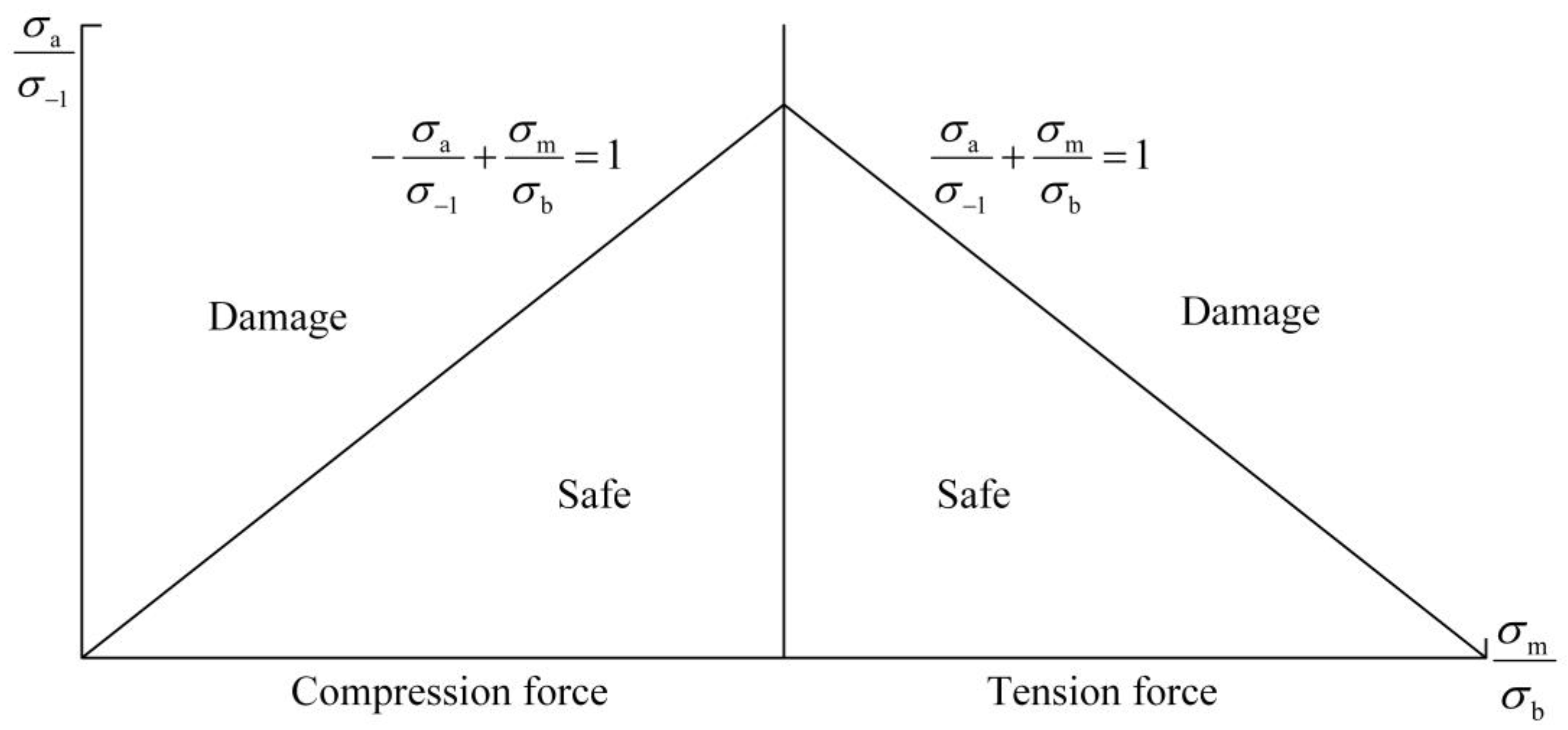


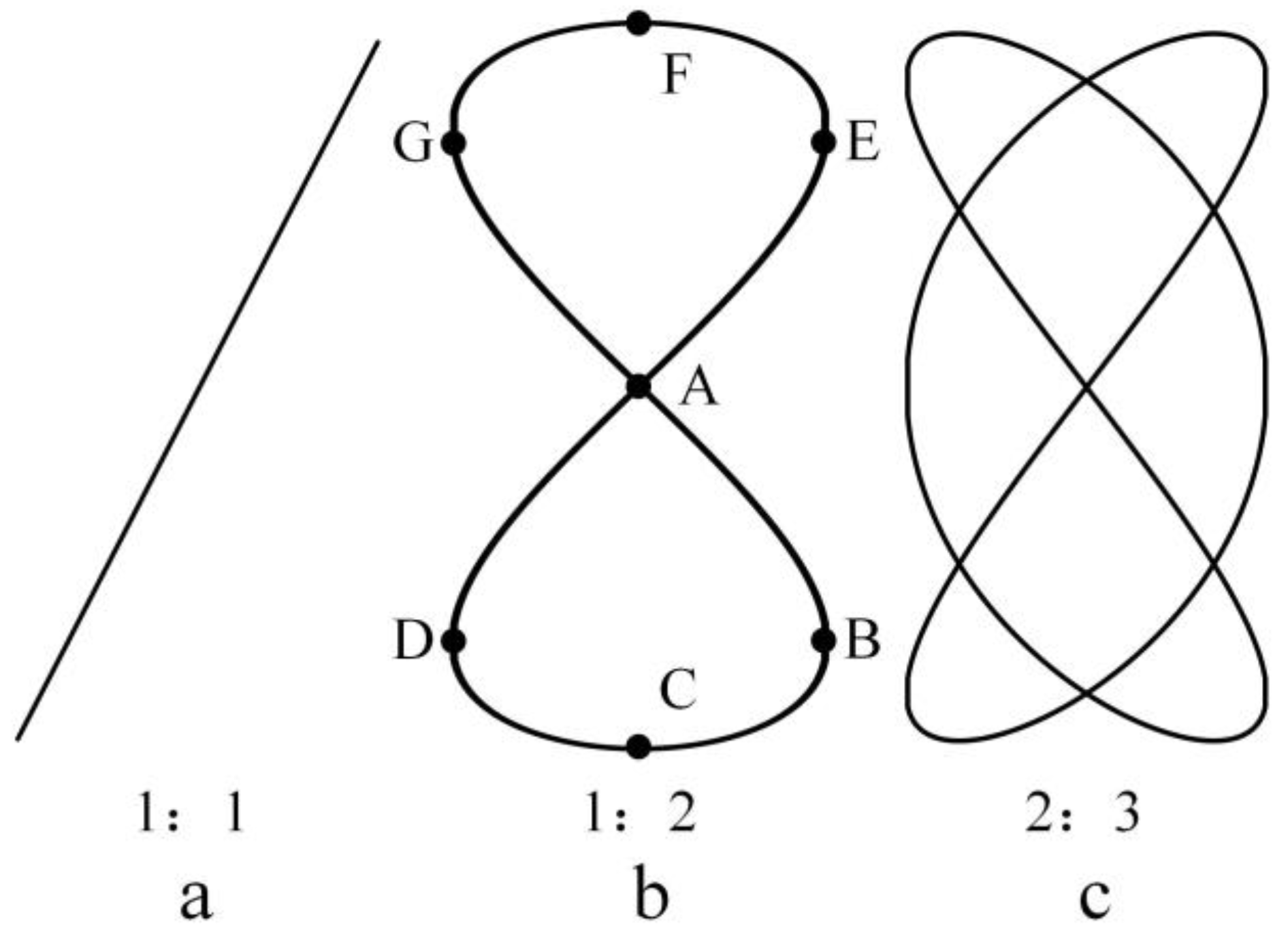
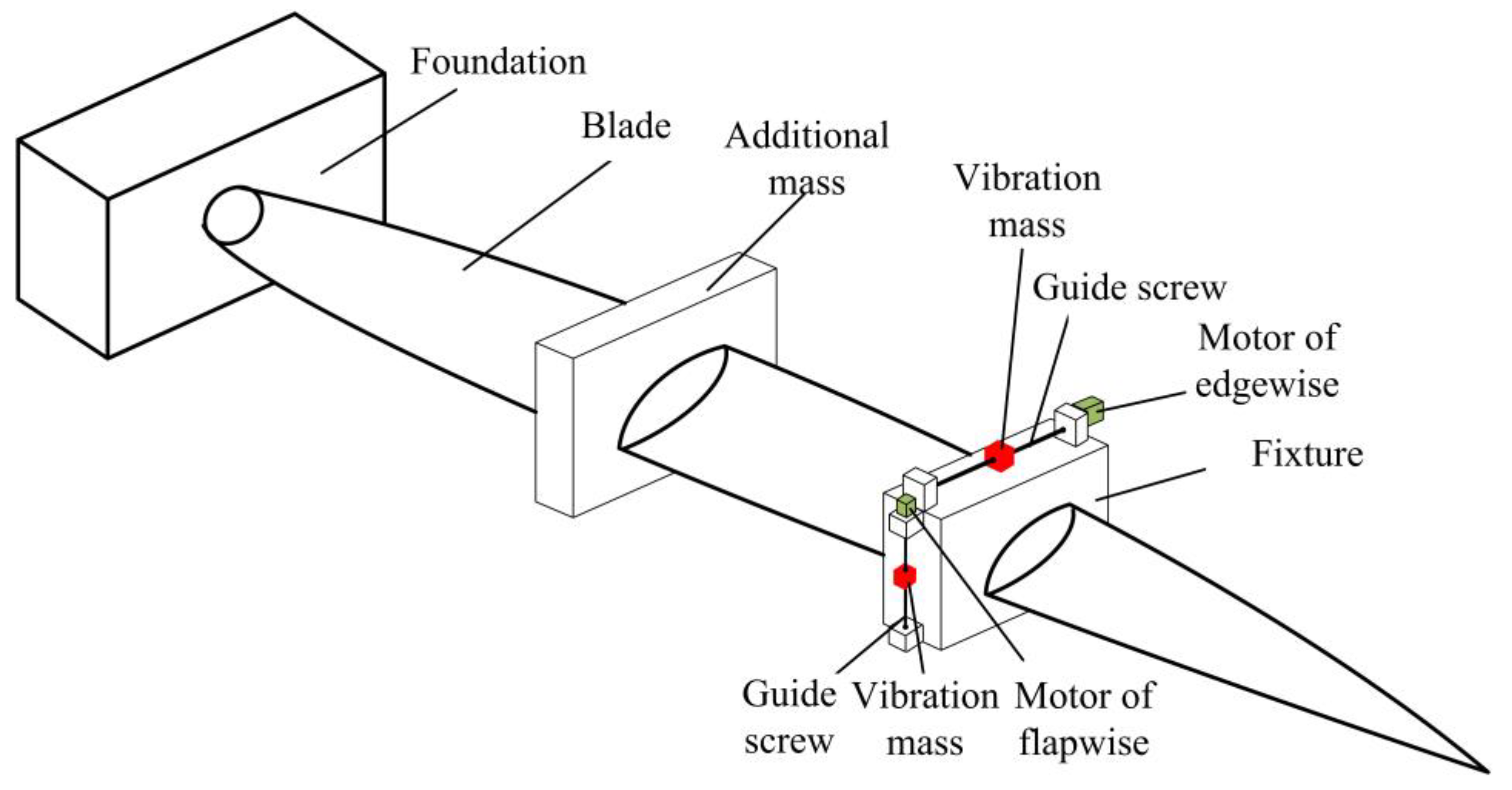

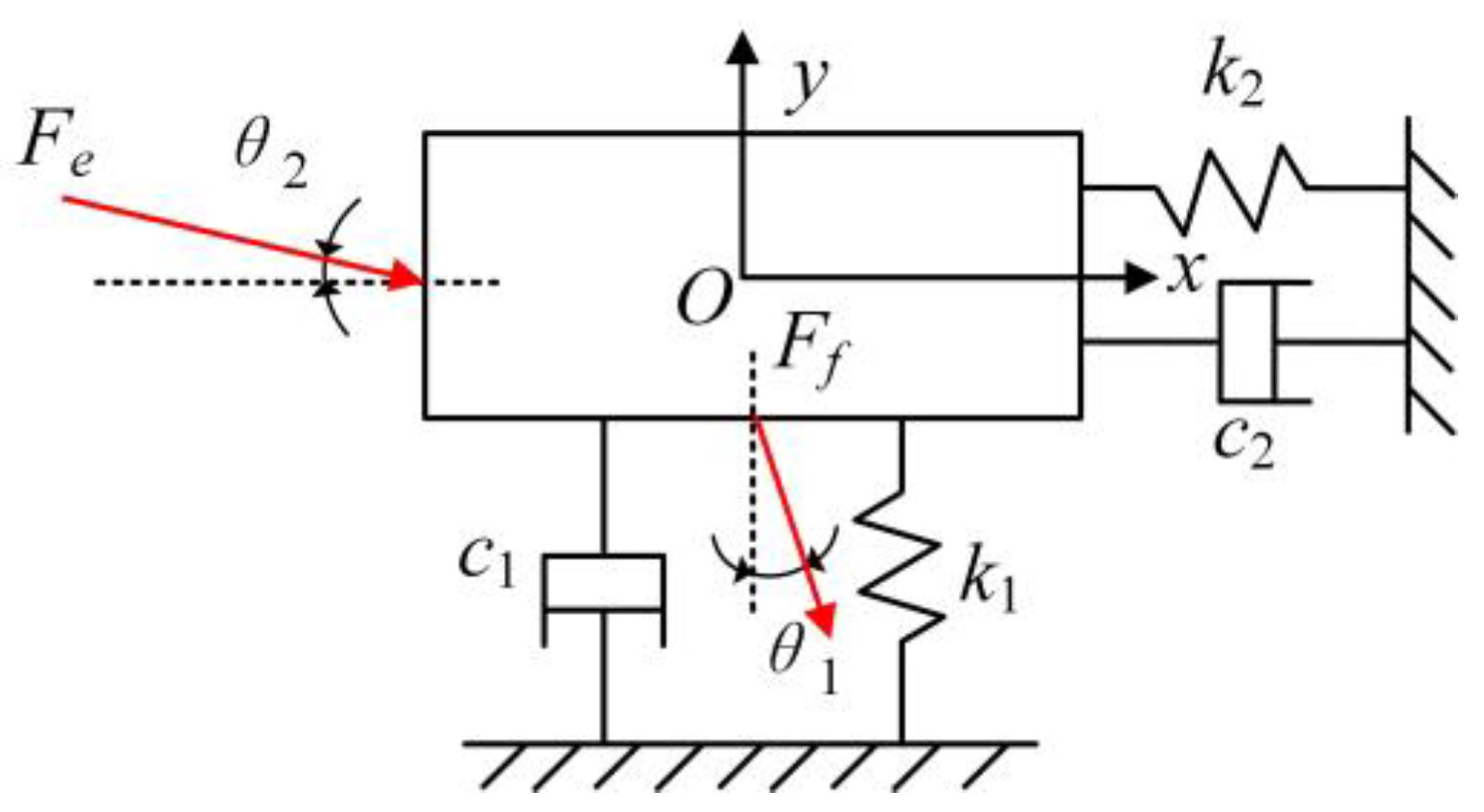
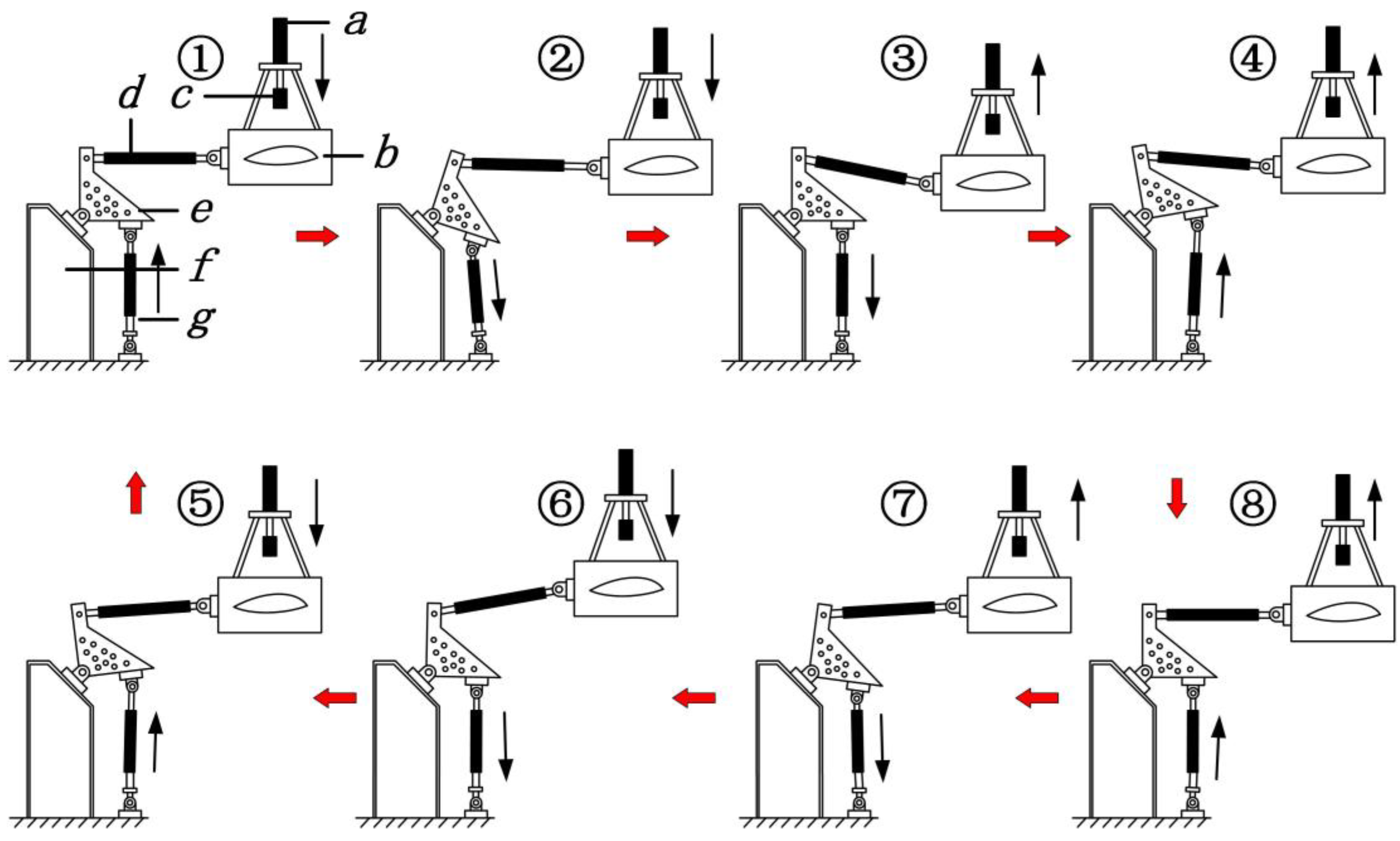
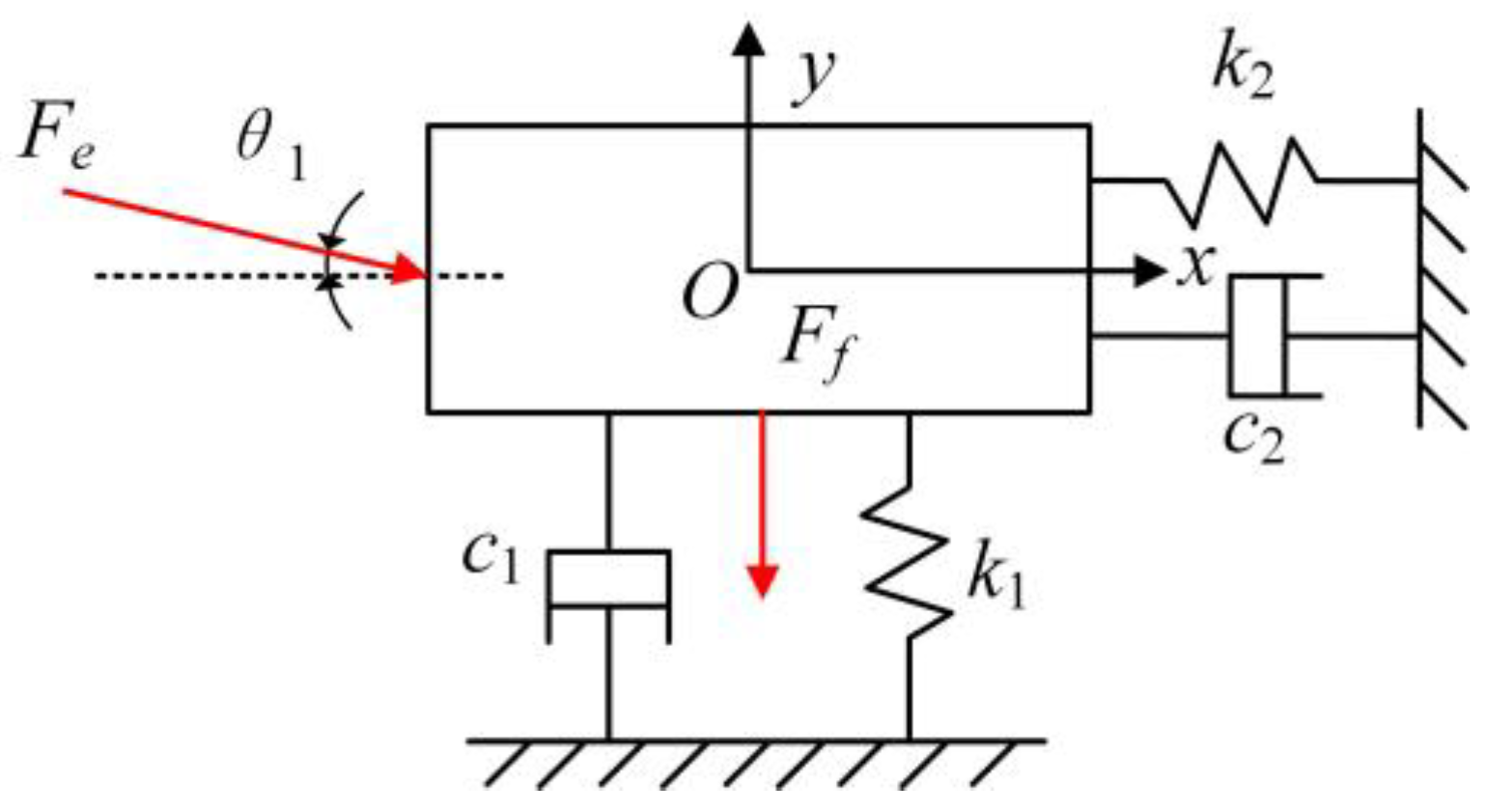
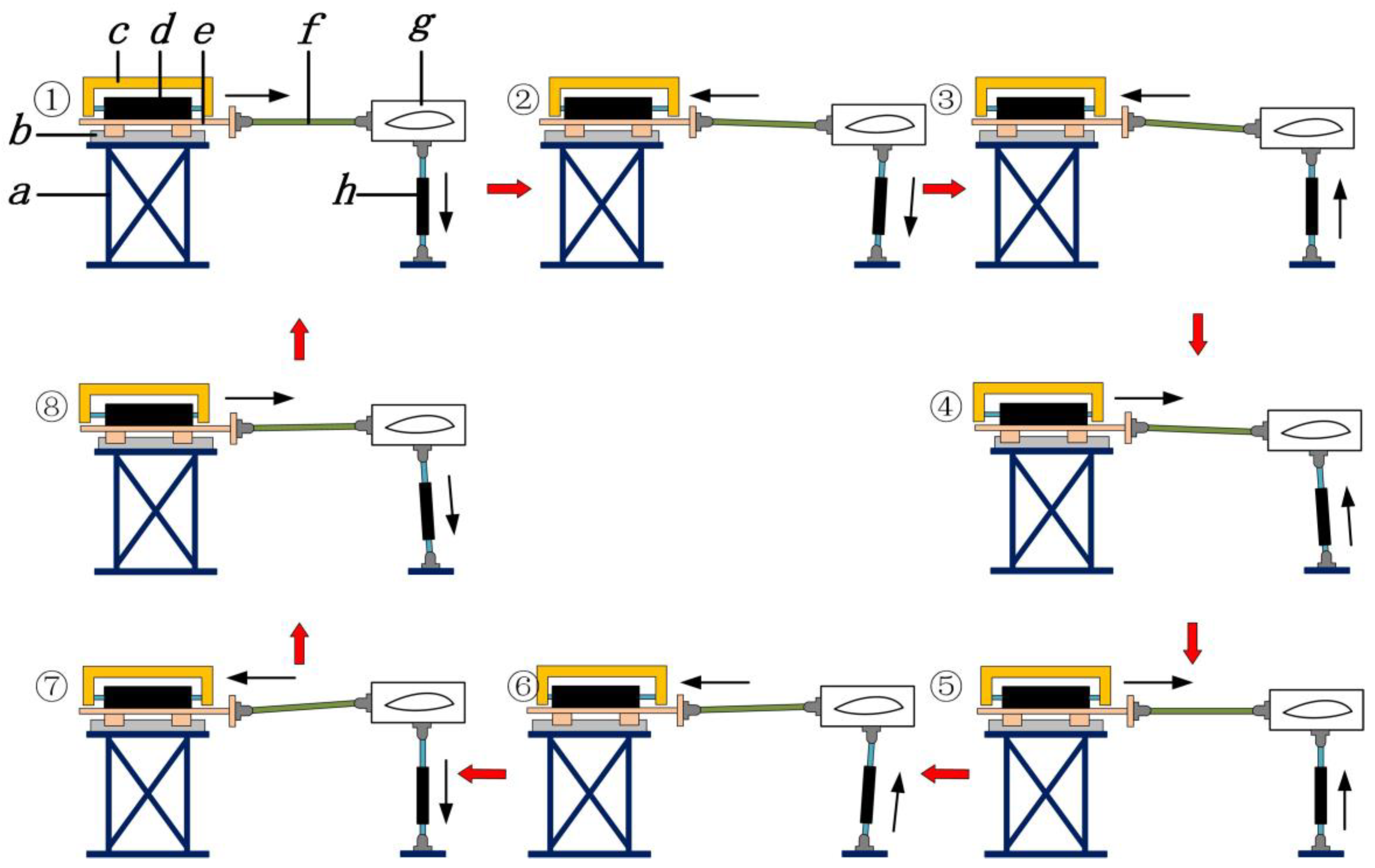
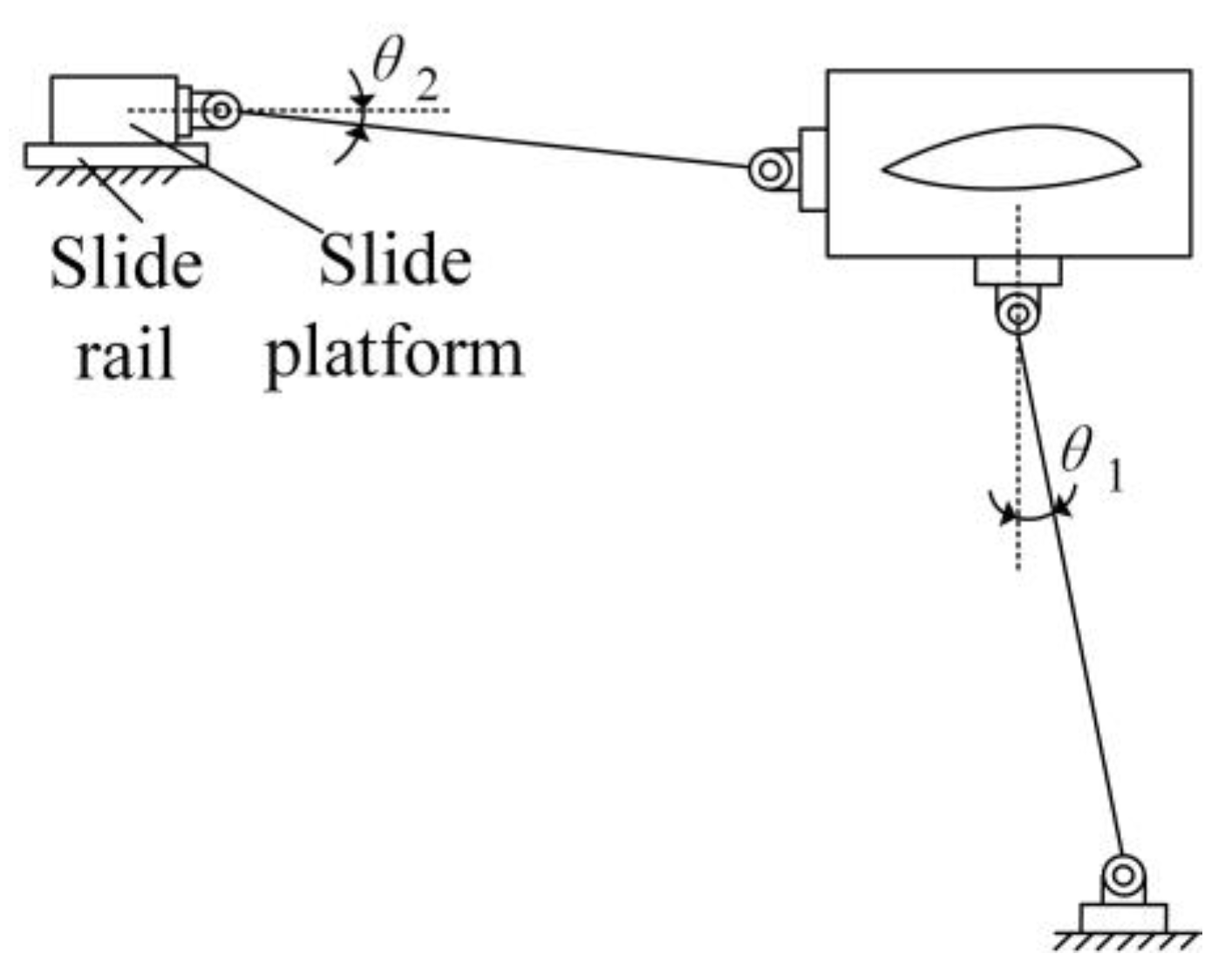
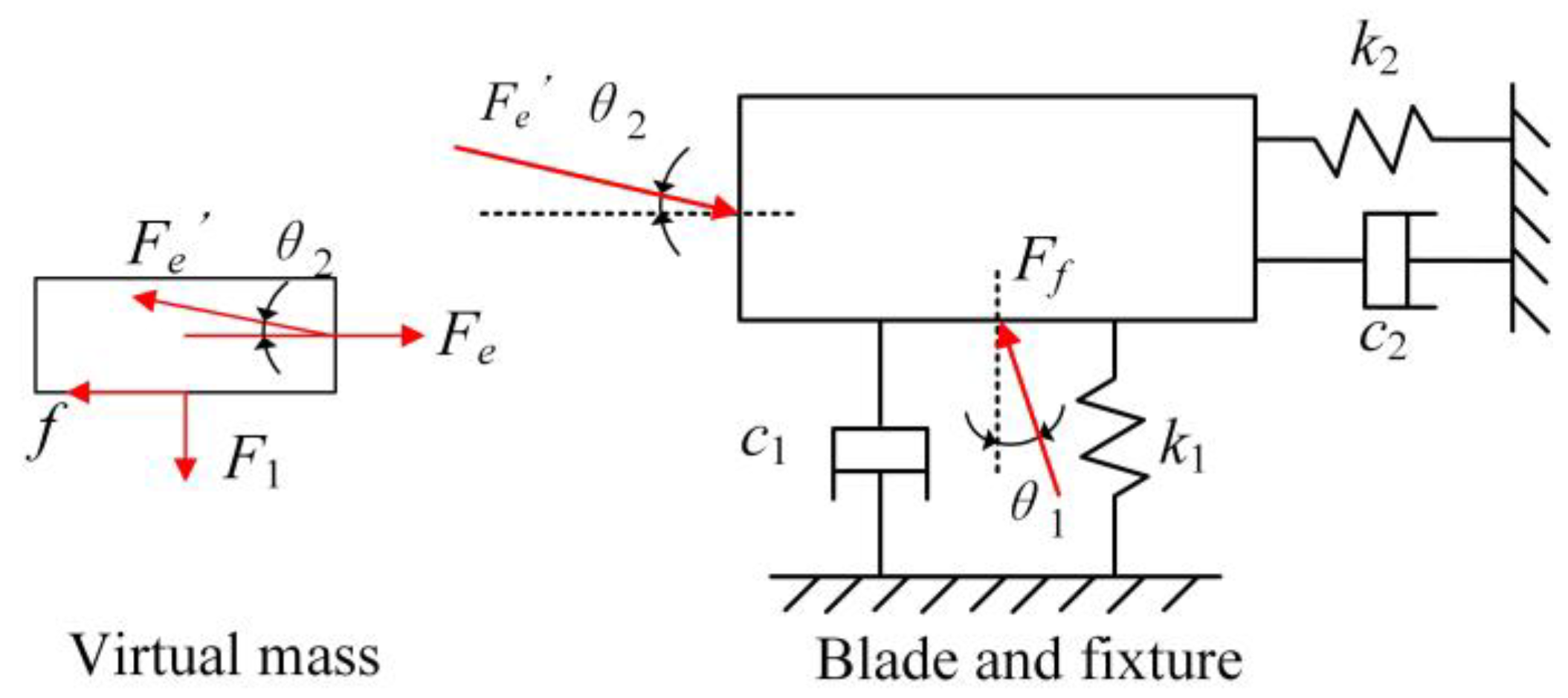
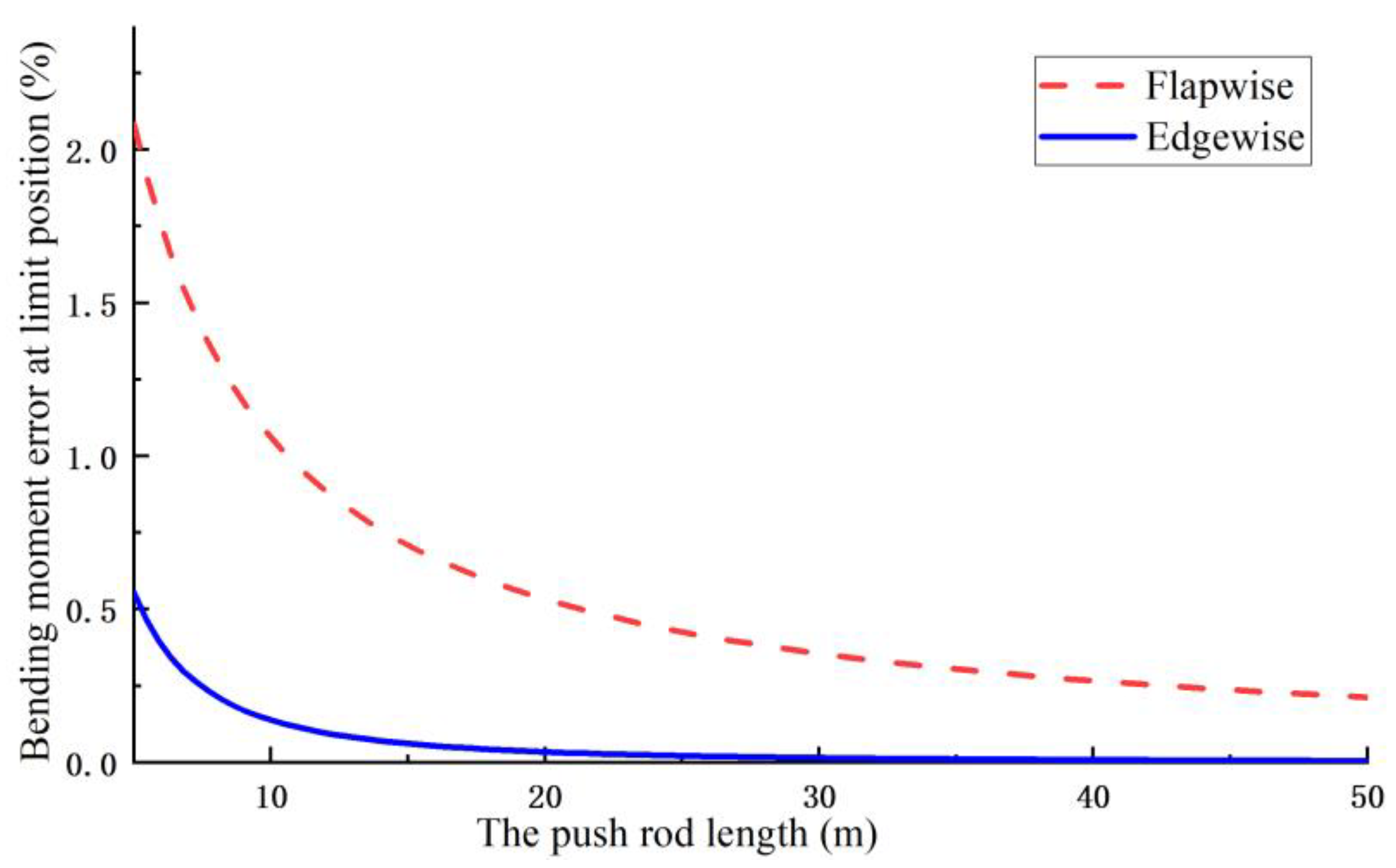


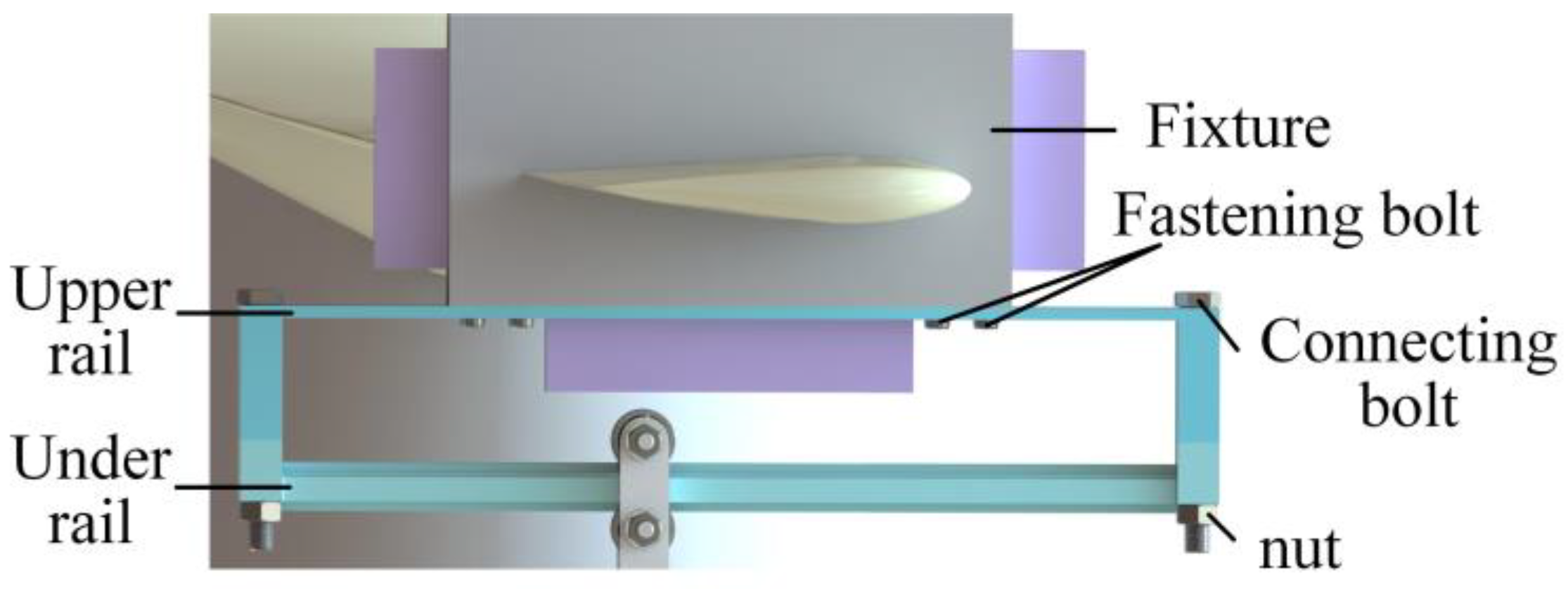

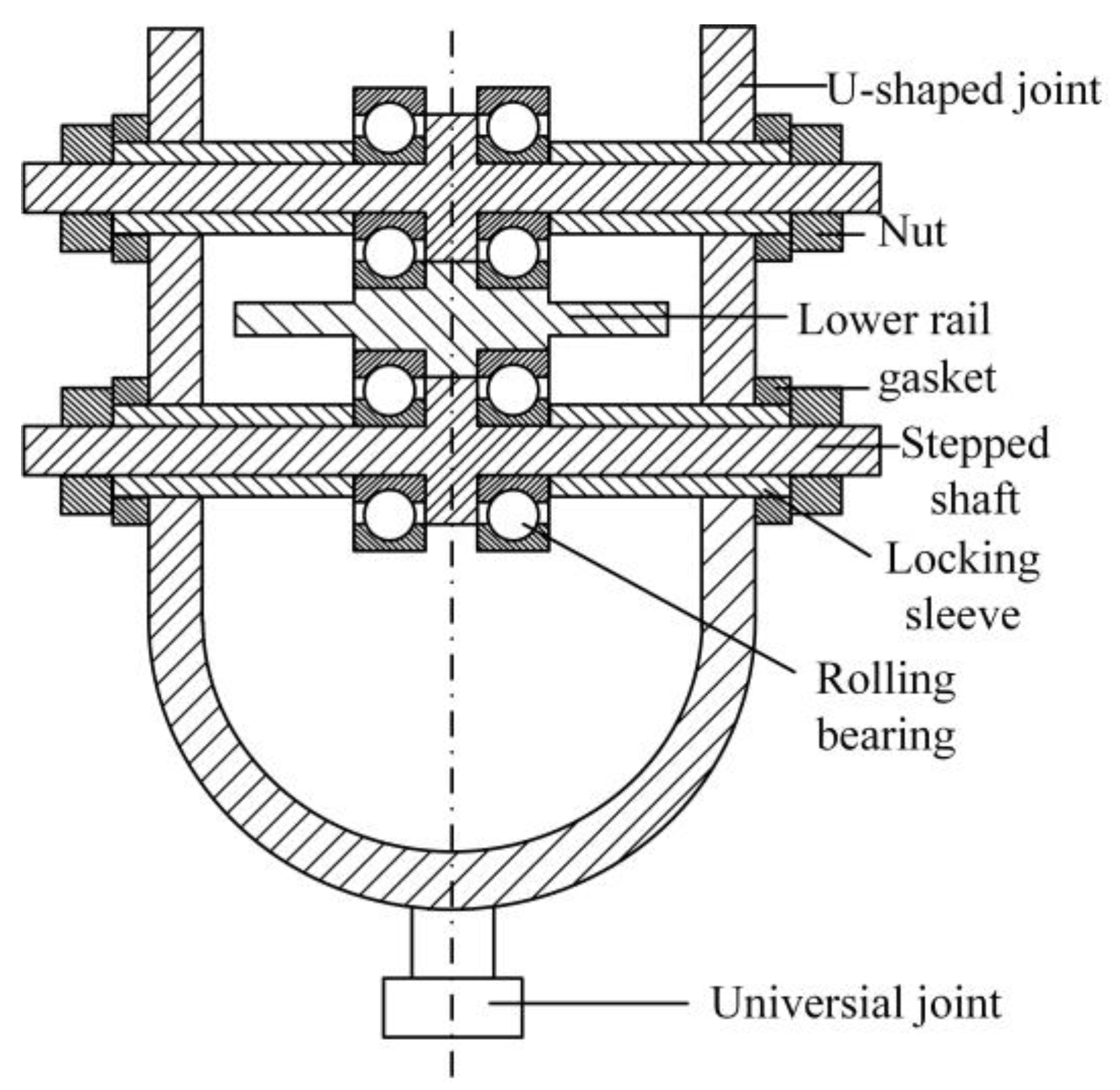

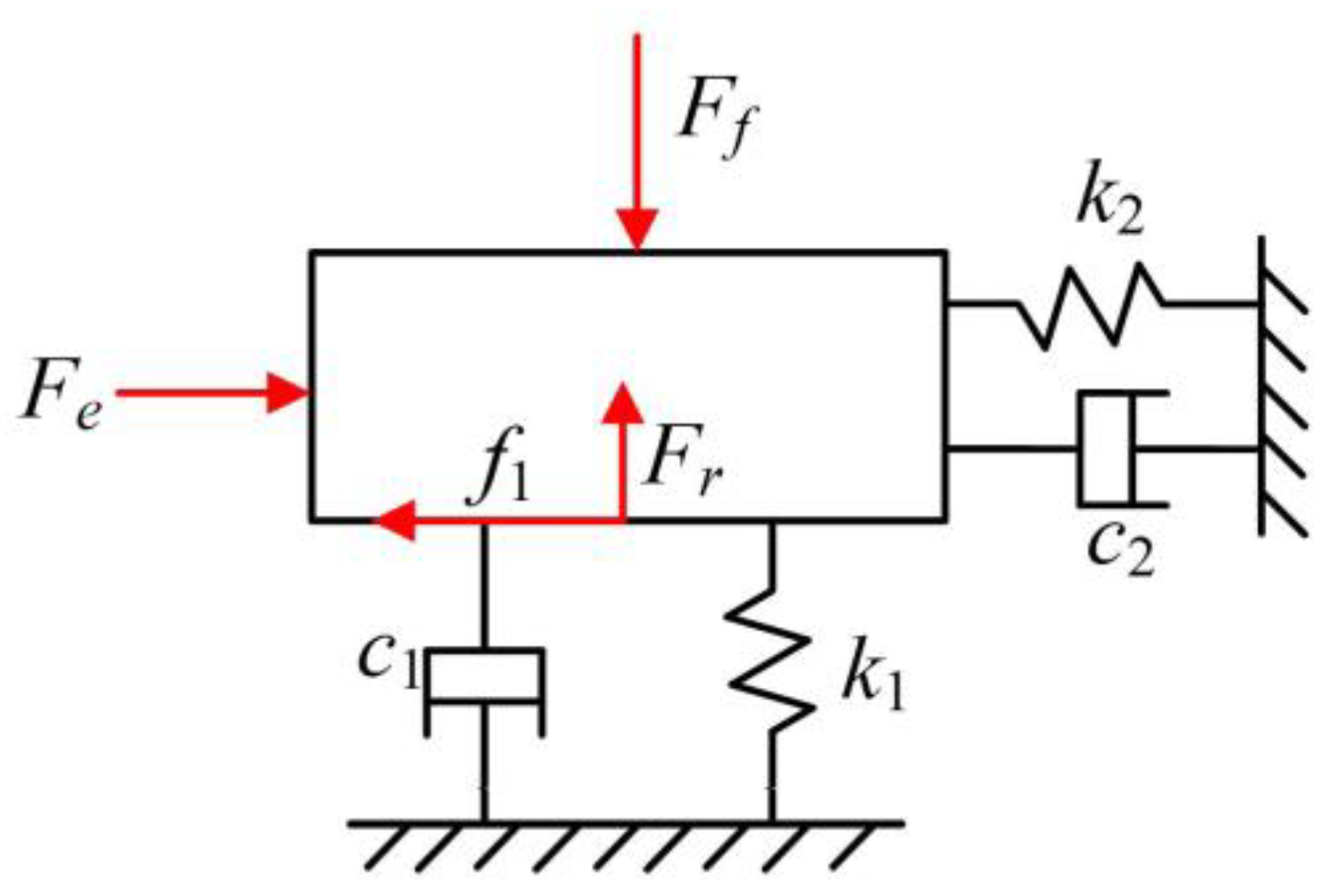
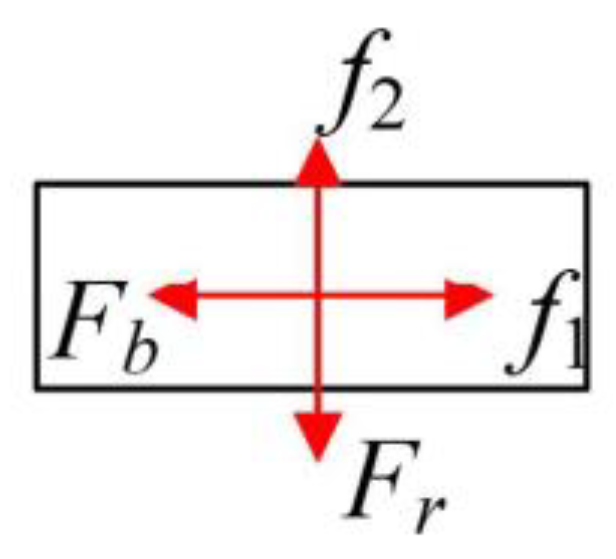


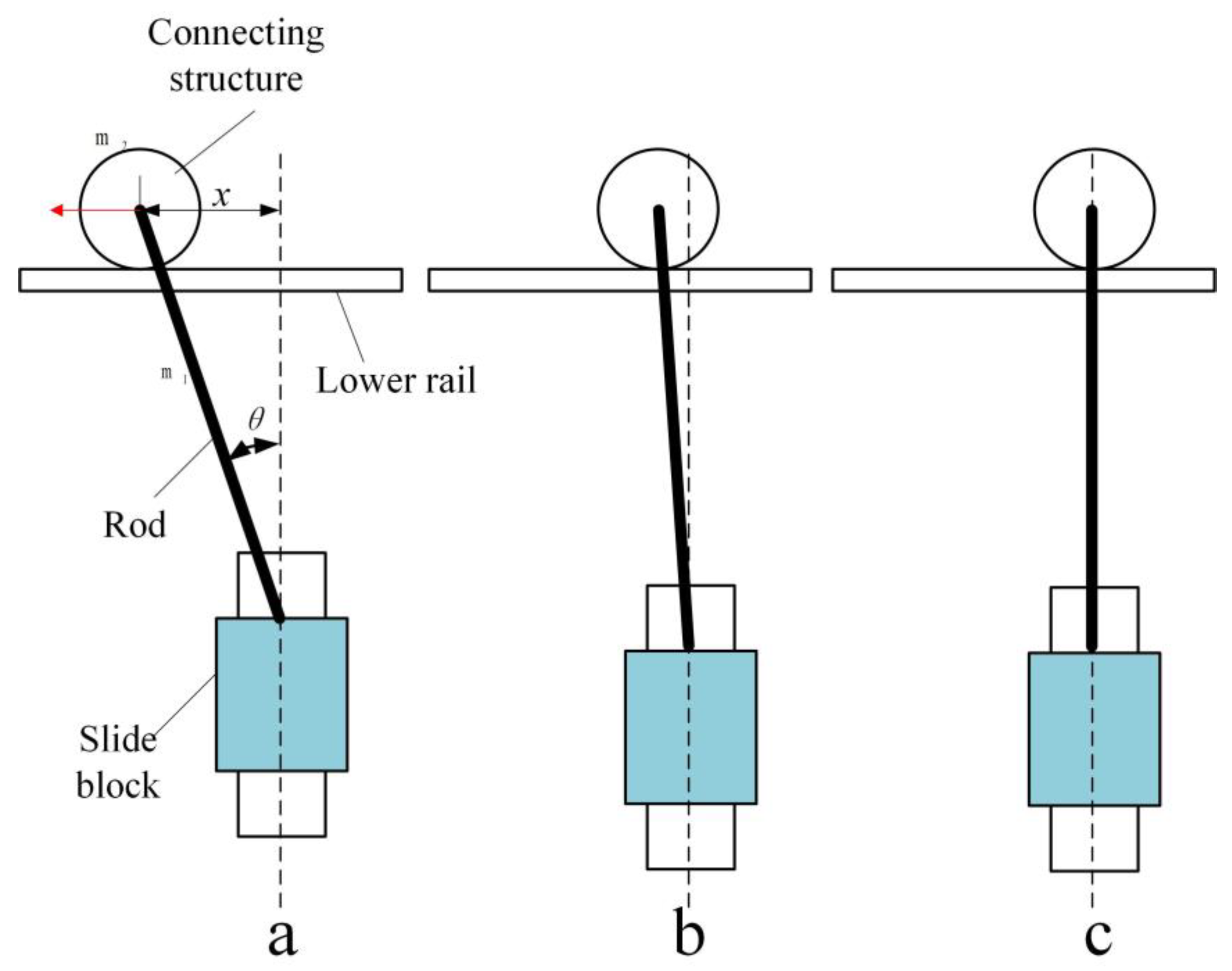




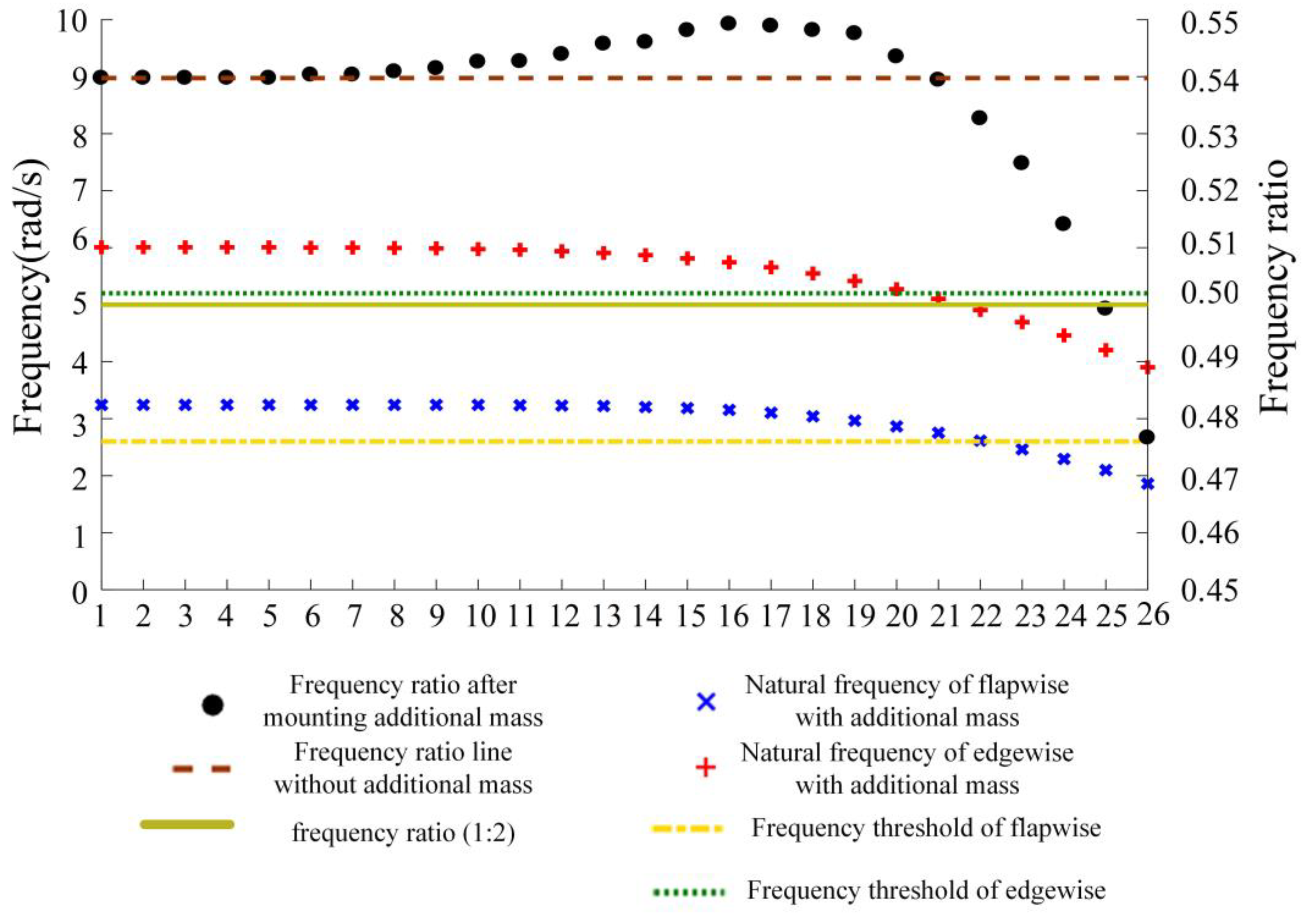
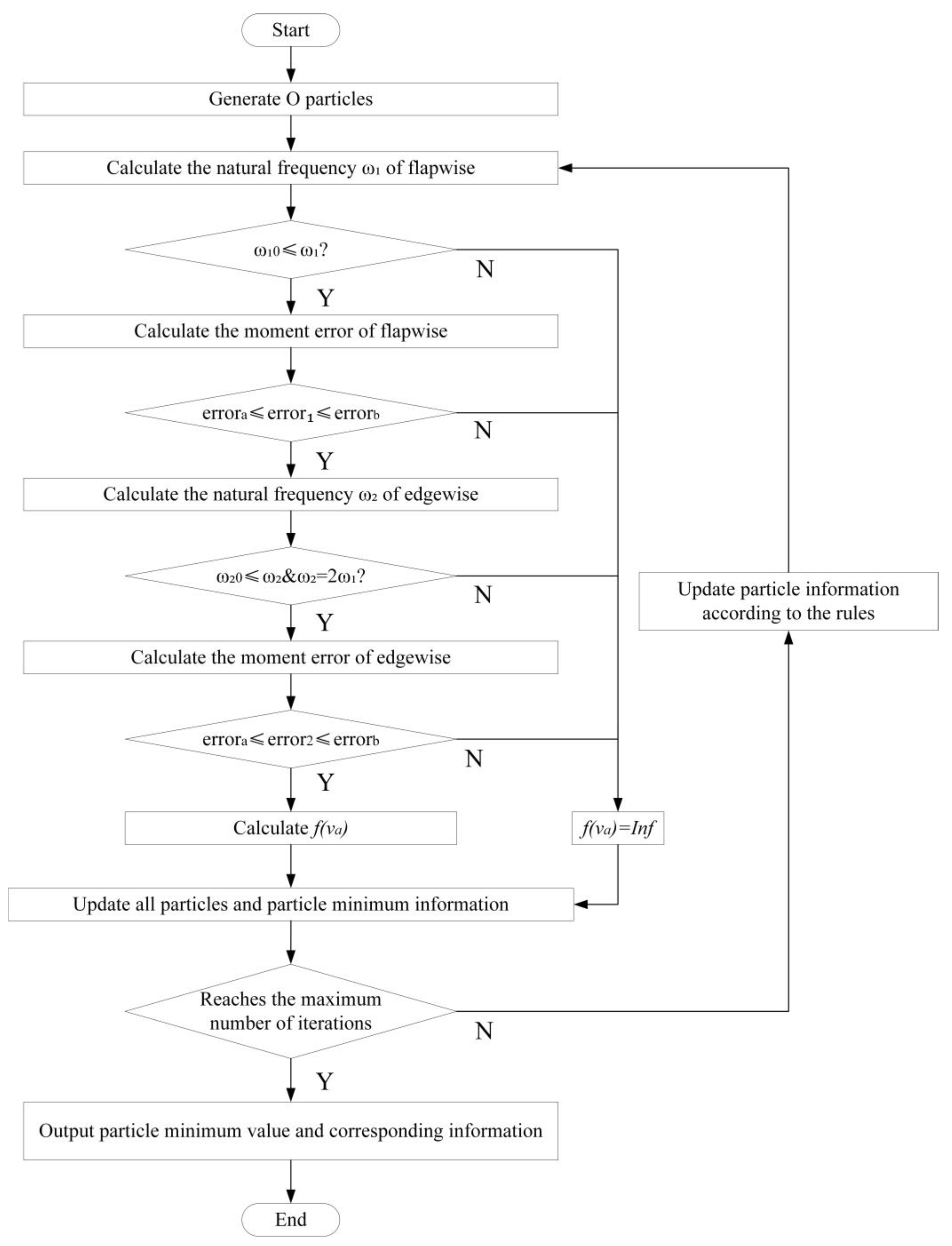


| Parameter | Value | Parameter | Value |
|---|---|---|---|
| 0 | |||
| 0 | |||
| 0 | |||
| 400 | 200 | ||
| 2 | 2 | ||
| 0 to 1 | 0 to 1 | ||
| 0.8 | |||
| Mass Block | Δm1 | Δm2 | Δm3 | Δm4f | Δm4e | Δm5f | Δm5e | Flashing Blade Root Bending Moment | Oscillating Blade Root bending Moment | Standard Deviation |
| Mass (kg) | 3282.3 | 3000 | 3500 | 735 | 200 | 450 | 50 | |||
| Location (m) | 19.2 | 24 | 28.8 | 43.2 | 43.2 | 50.4 | 50.4 | 8741 | 10,500 | 0.0548 |
Publisher’s Note: MDPI stays neutral with regard to jurisdictional claims in published maps and institutional affiliations. |
© 2022 by the authors. Licensee MDPI, Basel, Switzerland. This article is an open access article distributed under the terms and conditions of the Creative Commons Attribution (CC BY) license (https://creativecommons.org/licenses/by/4.0/).
Share and Cite
Lu, L.; Zhu, M.; Wu, H.; Wu, J. A Review and Case Analysis on Biaxial Synchronous Loading Technology and Fast Moment-Matching Methods for Fatigue Tests of Wind Turbine Blades. Energies 2022, 15, 4881. https://doi.org/10.3390/en15134881
Lu L, Zhu M, Wu H, Wu J. A Review and Case Analysis on Biaxial Synchronous Loading Technology and Fast Moment-Matching Methods for Fatigue Tests of Wind Turbine Blades. Energies. 2022; 15(13):4881. https://doi.org/10.3390/en15134881
Chicago/Turabian StyleLu, Liang, Minyan Zhu, Haijun Wu, and Jianzhong Wu. 2022. "A Review and Case Analysis on Biaxial Synchronous Loading Technology and Fast Moment-Matching Methods for Fatigue Tests of Wind Turbine Blades" Energies 15, no. 13: 4881. https://doi.org/10.3390/en15134881
APA StyleLu, L., Zhu, M., Wu, H., & Wu, J. (2022). A Review and Case Analysis on Biaxial Synchronous Loading Technology and Fast Moment-Matching Methods for Fatigue Tests of Wind Turbine Blades. Energies, 15(13), 4881. https://doi.org/10.3390/en15134881






